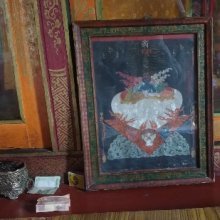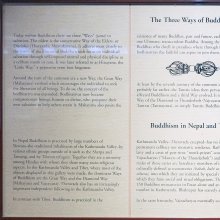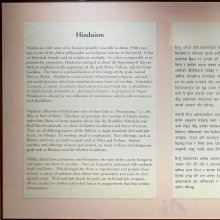Meat: 2 definitions
Introduction:
Meat means something in Hinduism, Sanskrit. If you want to know the exact meaning, history, etymology or English translation of this term then check out the descriptions on this page. Add your comment or reference to a book if you want to contribute to this summary article.
Images (photo gallery)
In Hinduism
Ayurveda (science of life)
Veterinary Medicine (The study and treatment of Animals)
Source: Asian Agri-History: Paśu Āyurvēda (Veterinary Medicine) in GaruḍapurāṇaMeat (in Sanskrit: māṃsa) is used in the treatment of various disorder, according to sections on Horses (Gajāyurveda or Aśvāyurveda) in the Garuḍapurāṇa.—[Management of miscellaneous disorders]—The drugs along with decoction of triphalā are advised if the horse is affected by vraṇa (ulcers)/kuṣṭha/khañja (lameness). The medicines should be administered with gomūtra (cow’s-urine) in mandāgni (impaired digestion), śotharoga (swelling/oedema). If they are affected by vātapitta, vraṇa (ulcers) the ghṛtasaṃyukta-gokṣīra (cow's milk along with ghee) is advised. If the horse is kṛṣa (emaciated), the diet shall be supplemented by māṃsa (meat) for puṣṭyārtha (to improve the body).

Āyurveda (आयुर्वेद, ayurveda) is a branch of Indian science dealing with medicine, herbalism, taxology, anatomy, surgery, alchemy and related topics. Traditional practice of Āyurveda in ancient India dates back to at least the first millenium BC. Literature is commonly written in Sanskrit using various poetic metres.
Shaktism (Shakta philosophy)
Source: Google Books: ManthanabhairavatantramThe Meat is sometimes associated with Śrīnātha—one of the Sixteen Siddhas according to the Manthānabhairavatantra, a vast sprawling work that belongs to a corpus of Tantric texts concerned with the worship of the goddess Kubjikā.—These sixteen spiritual teachers represent the disciples of the Nine Nāthas who propagated the Western Transmission noted in the Kubjikā Tantras.—Various texts record the locations of the sixteen Siddhas within the body (called ‘doors’). For example, the Kulakaulinīmata mentions the Right armpit, whereas the Ṭīkā mentions the Eye and the Kumārikākhaṇḍa mentions Meat as the location of Śrīnātha.

Shakta (शाक्त, śākta) or Shaktism (śāktism) represents a tradition of Hinduism where the Goddess (Devi) is revered and worshipped. Shakta literature includes a range of scriptures, including various Agamas and Tantras, although its roots may be traced back to the Vedas.
See also (Relevant definitions)
Starts with: Boar flesh, Human flesh, Meat Eating, Meat soup, Pigeon meat.
Query error!
Full-text (+1413): Mamsa, Bharutaka, Shulya, Vishra, Amisa, Sauna, Shulyamamsa, Busta, Vimamsa, Mamsika, Takramamsa, Custa, Rasaka, Grinjana, Mamsavikraya, Lava, Mamsashana, Varaha, Amishapriya, Sharkaka.
Relevant text
Search found 339 books and stories containing Meat, The meat; (plurals include: Meats, The meats). You can also click to the full overview containing English textual excerpts. Below are direct links for the most relevant articles:
Charaka Samhita and Sushruta Samhita (by Nayana Sharma)
Certain aspects of dietary regimen < [Chapter 7]
Dietary and Lifestyle measures based on the six Seasons < [Chapter 6]
Hygiene and Environmental Issues (Introduction) < [Chapter 6]
International Ayurvedic Medical Journal
Meat consumption from an ayurveda perspective < [2020, Issue 4, April]
A review article- importance of pathya-apathya in daily life < [2023, Issue 06, June]
A review article on ayurvedic approach of krimi roga and its management w.s.r to worm infestation < [2017, Issue II February,]
World Journal of Pharmaceutical Research
Increased cancer risk linked to high red, processed, and grilled meat. < [2019: Volume 8, September issue 10]
Effects of papain spices mixture (spizym) on meat tenderness < [2017: Volume 6, December issue 16]
Pork meat from the viewpoints of quran and medical research < [2015: Volume 4, August issue 8]
Charaka Samhita (English translation) (by Shree Gulabkunverba Ayurvedic Society)
Chapter 8 - The therapeutics of Consumption (raja-yakshma-cikitsa) < [Cikitsasthana (Cikitsa Sthana) — Section on Therapeutics]
Chapter 12 - The remaining best kinds of Enema (uttara-basti-siddhi) < [Siddhisthana (Siddhi Sthana) — Section on Successful Treatment]
Chapter 27 - Diet and Dietetics (Annapana-vidhi) < [Sutrasthana (Sutra Sthana) — General Principles]
Physician as depicted in Manasollasa (by Sri B. S. Hebballi)
9. Ritucarya (conduct during different seasons) < [Chapter 4 - Ancient treatises on Indian medicine]
3. Quantity of food and digestion < [Chapter 6 - Restoring normal physical and mental health]
5. Dinacarya (timetable for the healthy person) < [Chapter 4 - Ancient treatises on Indian medicine]
Diet and regimen during pregnancy < [Volume 28 (issue 1), Jul-Sep 2008]
Modern science supports ancient Ayurvedic diet for diabetes. < [Volume 25 (issue 3-4), Jan-Jun 2006]
Rhazes’ concepts and manuscripts on nutrition in treatment and health care < [Volume 31 (issue 4), Apr-Jun 2012]
Related products
(+7 more products available)








